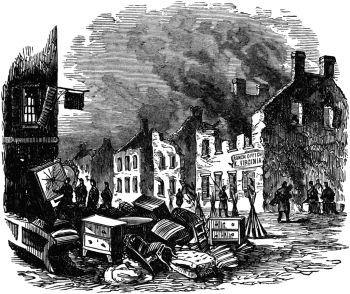 The Confederate victory at Fredericksburg is evident to all. Commanding strategic locations in and around the city, Southern forces have slaughtered their Northern counterparts thus far, and are prepared to continue the slaughter today. For his part, Union General Ambrose Burnside yet wishes to press his offensive against Confederate General Robert E. Lee‘s forces, but his officers persuade him otherwise. Evidencing tactical skill not evident in the prior days of battle, late today Burnside begins an effective disengagement from the battlefield, retreating across the Rappahannock River and hunkering down on safer ground.
The Confederate victory at Fredericksburg is evident to all. Commanding strategic locations in and around the city, Southern forces have slaughtered their Northern counterparts thus far, and are prepared to continue the slaughter today. For his part, Union General Ambrose Burnside yet wishes to press his offensive against Confederate General Robert E. Lee‘s forces, but his officers persuade him otherwise. Evidencing tactical skill not evident in the prior days of battle, late today Burnside begins an effective disengagement from the battlefield, retreating across the Rappahannock River and hunkering down on safer ground.
By the end of the day, the battle is over. The casualties are enormous and lopsided: 17,929 total, including 13,353 United States soldiers and 4,576 Confederate soldiers. Although the far superior numerical manpower of the North will soon negate the slaughter on the Union side, Burnside’s military career will never fully recover from his misguided invasion of Fredericksburg.
The city is damaged almost beyond recognition. One soldier observed:
Fredericksburg is all knocked to pieces. Every house almost is full of holes where the shells have been sent. Possibly it may be repaired again but I think [it] doubtful.
A Georgian who toured Fredericksburg after the battle described what he saw, in a letter to home.
There is scarcely a house in the town that has not some mark of the siege. Chimneys knocked off, roofs torn up, and walls scarred with holes of various sizes, some as large as a man’s head and others as large as a flour barrel.The large tall houses suffered more than the low buildings. A large Baptist Church [Fredericksburg Baptist Church] has fifteen large holes through the walls, four through the steeple and the roof torn up in many places. I think there are twenty five or thirty houses burned.
Like so many other buildings in town, the Baptist churches of Fredericksburg are left severely damaged. Bullet and canon holes, shattered windows, damaged or stolen pews, broken and or missing furniture, and shredded or missing books and other items characterize the destruction. Yet the war is far from over, and not until spring and summer of 1865 does even a small sense of normalcy begin returning to the houses of worship. Wealthy members assist in paying for repairs, with some Northern Baptist churches also sending funds. In the decades following, the churches also seek redress from the United States government, which eventually does send payments to cover some of the damages.
Sources: The Battle of Fredericksburg (link); Donald C. Pfanz, “The Battle of the Bridges: Behind the Lines” (link); Michael Aubrecht, “Indemnity in Black and White” (link)


